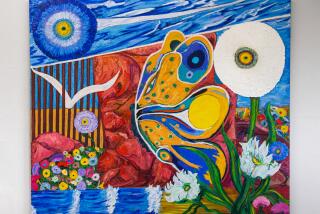Visiting a Land Where Dreams Began
- Share via
NEW YORK — We climbed the 354 steps, the last ones rising in a tight, shin-bruising spiral. The ascent took two hours, and Lady Liberty’s head was as hot as an aluminum shed on a Barstow summer morning.
But our work rewarded us with the privilege of participating in a key American ritual: viewing New York City, the fruit of a million lifetimes of labor, from the crown of the statue that rekindled the city’s immigrant builders’ courage.
Fingering the riveted seams, my wife, Pam, and our children--Ashley, 12, Emily, 10 and Robert, 7--craned to look through the jade-colored copper portals.
Ashley’s attention then snapped back to the pink and purple plastic gadget dangling from her neck.
Would a 19th century immigrant child, fresh off the boat from Poland or Armenia, understand the distractive force of a Tamagotchi? Could an 18th century child, arriving enslaved from Africa, make sense of a culture’s eagerness to cater to the “needs” of a digitized doll worn like a locket--a gimmick toy as ubiquitous in urban environs this summer as trampolines are across rural America?
Who knows? Maybe so. Which is more than I can say for myself.
We arrived in New York City by train, having parked the RV at a campground far up the Hudson River. From our navigation through Grand Central Station to our sumptuous deli lunch and evening ride to Times Square in a cab with a dashboard advising “There is no God but Allah,” there would be no doubt about the theme of this chapter in our summer-long exploration of the state of America’s families.
We’d already visited Jamestown and Gettysburg and Philadelphia’s Independence Hall. But New York City represents a historical thread that arguably is as important as our nation’s wars and document signings.
And the immigrant story is more vital.
This summer, New York seems remarkably comfortable with its multicultural layers. As we strolled trendy West Side streets and the paths of Central Park, I had to remind myself that the swarms of interracial couples--black and white, Latino and Asian, and every combination thereof--did not always blend in so seamlessly. Our kids didn’t even notice the color combos. But they couldn’t help but absorb the buzzing city’s ethnic complexity.
Our first night in town, we scrambled for theater tickets and our split-second choice of a show proved providential. A Ticketron foul-up landed us in four spectacular seats and a distant fifth. At intermission I scanned the theater for Robert’s fresh New York City haircut. He caught my eye, grinned and pumped his upturned thumb toward the ceiling. His mother and sisters were equally enthusiastic.
“Titanic” is about immigrants’ dreams and humankind’s hubris; about bluebloods riding out their forebears’ foresight, and Irish naifs determined to thrive in the land of milk and honey.
It’s also about destiny.
The play stuck with us the next day as we met our friends Barry and Amy and her 7-year-old daughter, Joanna, in Battery Park and loaded onto a crowded ferry for the Statue of Liberty.
By then, our girls had spotted the Tamagotchi dangling from Joanna’s neck and practically trembled with envy. This strange fad had just hit when we left L.A. Since our home is a Nintendo-free zone, we weren’t about to allow such gadgetry into the rented RV in which we are traveling.
Clearly, though, the trend had gained momentum even without our approval. Amy said that at her daughter’s day camp in suburban Westchester County, for instance, mothers stand around the pool anxiously juggling their children’s brood of Tamagotchis, whose programmed needs for “food” and “play” demand endless button pushing.
When Joanna offered to let our girls share her toy for the day, their focus immediately shifted away from our nearly sacred surroundings. This annoyed Pam and me. But we also had to admit that it wasn’t till we had our own offspring that we fully grasped the need to honor those who came before us.
After descending from the statue, our entourage ate lunch and I made my reportorial rounds, intruding on families recently emigrated from the Dominican Republic, India, Nigeria and China, among other places.
Some shrugged and said the statue was simply another attraction to check off their lists. Others clearly were drawn to this totem for deeper reasons that they struggled with varying success to articulate.
“To me, it stands for open arms for people who immigrate,” said Shree Nanguneri, who had come to Liberty Island with his wife, Sasi Kobilan, and her parents, visiting from their home in Madras, India.
“We immigrated for opportunity and freedom,” he said. Their opportunity means working for General Electric and running a small business on the side, he said. The freedom they pursued is different only in nuance from the freedom some of my ancestors sought when they left Scotland and England centuries earlier or Ireland and Germany more recently.
“Here, whatever background you are, you can make a mistake and come back,” Nanguneri said. “You can pick a new career. Try again. People here are always going back to school. It’s not like that in India.”
The family posed for a picture, and when I asked about the baby, Nanguneri smiled. “Eight months old,” he said. “Made in the USA.”
*
Adisplay at Ellis Island’s Immigration Museum sums up the situation: “Since 1600, over 60 million people from throughout the world have come to the United States, creating a multiethnic nation unparalleled in history.”
On one big map of the U.S., visitors of every ethnic description line up to press buttons for Italy or Germany or Cameroon, and the states that have the most descendants of those nationalities light up along with the census numbers.
Barry’s Jewish ancestors arrived in Boston, and perhaps Ellis Island as well. Amy said her great-grandparents passed through Ellis Island in a wave of Jewish immigration from Poland and Russia. But the family doesn’t talk much about it, leaving her longing to know more.
Only Pam had a clear tale to tell, the one she’d learned from her father’s mother about her own journey to the United States from Hungary near the turn of the century. She’d been 14, and from the time her father put her on a train in Budapest until the time she passed through Ellis Island and traveled on to Chicago, she never saw a familiar face.
It’s hardly a unique tale, though. I bought a book called “Immigrant Kids” in the Liberty Island gift shop, and the photos had sufficient strength to coax from my own children an empathy for the fear and loneliness of the young immigrants clutching flags on Ellis Island’s rooftop playground, or standing wide-eyed with their parents amid wicker baskets and pillow case bundles.
Elsewhere in the museum is a remarkable display of black-and-white portraits of children who passed through Ellis Island decades ago and who now have grown to old age in their new country.
A caption beside a portrait of wizened Elda Del Bino Willitts, who arrived from Italy in 1916 at age 5, says a lot: “The dreams of my parents really did come true.”
Our day at the great immigrant gateway left us with a cosmopolitan hunger. For dinner we shared a whole red snapper in chili sauce, seasoned squid, rice, vegetables, noodles, summer rolls, shrimp pa^te grilled on sugar cane, and hot and sour soup at a raucous Vietnamese restaurant in Chinatown.
Afterward, with the kids weaving between carts and people’s legs, we strolled though the open-air fish and produce markets until the aroma of Chinese garlic sauces was overcome by Italian-style garlic scents. In Little Italy, we sat at a sidewalk cafe and ate Italian ices, cannoli and strawberries dipped in chocolate as an intoxicating summer breeze coaxed the waitresses to rumba.
As we strolled, window shopping, back through Chinatown, a girl--an African American, as it happens--strained against her parents’ grip to grill Emily eagerly about the Tamagotchi in her possession.
Although it’s not a perfect segue, I’m going to follow that scene back to another stop on our trip that is now linked irrevocably in my mind to Ellis Island and cries out to be added here as a coda.
*
This has been a summer of deepening discovery for our family about civil rights, and we had hoped that Sullivan’s Island off South Carolina would add to our education.
As we drove across the bridge from Charleston onto this sliver of sand and palm meadows and shade trees, we felt the allure of its balmy resort towns. We were impressed by certain vestiges of its critical role in history: Ft. Moultrie, which figured in both the Revolutionary and Civil wars, has been refurbished impressively as a national monument, for instance.
But there is no evidence at all of the other critical role the island played in U.S. history--as the port through which the vast majority of African slaves passed during the Colonial era.
Most of the African Americans I met in the shadows of the Statue of Liberty struggled to explain what had drawn them there. They expressed ambivalence about this monument to “huddled masses yearning to breathe free.” But still they came and ate hot dogs and bought knickknacks and wore green foam-rubber Lady Liberty crowns.
Only one woman had heard of that island to the south. We learned about it only because we’d stumbled upon a small article in U.S. News and World Report, in which a Duke University historian referred to Sullivan’s Island as “the Ellis Island of black Americans.”
There are efforts afoot in South Carolina to create a museum to educate Americans about the slave trade. Even as the nation fights out questions about racial apologies and reparations for slavery, supporting such an institution--a counterpart of sorts to the immigration museum on Ellis Island--seems like a no-brainer.
But Ellis Island would have far less impact without that statue towering on another island nearby.
So maybe it’s time for the descendants of immigrants who came here freely--and even those many who came as indentured servants--to build on Sullivan’s Island a symbol to recognize the immensely more difficult passage of our enslaved brethren.
It would be the exact size of the Statue of Liberty. It would depict an African slave couple, with chains on their legs and a child on their shoulders, and the child would be looking north, squinting hopefully for a glimpse of something that her parents can’t even imagine--that distant promise enshrined on Liberty Island.
ON THE WEB
Visit the Sipchens on the World Wide Web at https:// www.latimes.com/trip/ for maps, journals and sounds from the family’s trip.
* Monday: In Purchase, N.Y., the kids go to Circus Camp.
More to Read
Sign up for The Wild
We’ll help you find the best places to hike, bike and run, as well as the perfect silent spots for meditation and yoga.
You may occasionally receive promotional content from the Los Angeles Times.






